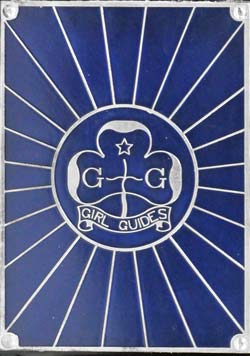Kodak Girl Guide UK
Specification

| Manufacturer | : | Kodak Co. (UK) |
|---|---|---|
| Produced | : | UK 1931 |
| Classification | : | Medium Format |
| Body Type | : | Folding Bed |
| Bellows Deployment | : | Sliding Rail |
| Construction | : | Metal |
| Film Type | : | 127 |
| Film Width | : | 46mm |
| ImageSize | : | 1⅝ x 2½ in |
| No. of Images | : | 8 |
| Lens Type | : | Meniscus |
| Focal Length | : | 75mm |
| Focus Type | : | Fixed |
| Focal Range | : | 6ft - inf. |
| Aperture Type | : | Multistop |
| Aperture | : | f/11, f/16, f/22, f/32 |
| Shutter Type | : | VP Rotary |
| Shutter Speeds | : | T, I*(1/50 sec) |
| Size Closed (w x h x d) | : | 70 x 125 x 24 mm |
| Size Open (w x h x d) | : | 70 x 125 x 100 mm |
| Weight | : | 310g |
| * Measured on this camera | ||
Art Deco Credentials
![]()
![]()
![]()
![]()
![]()
Iconic: Famous, well-known and celebrated
- Produced during the main Art Deco period.
- Designed by Walter Dorwin Teague
- Sun-burst design on base plate.
- Blue crackle finish on body.
- Chrome struts and film door lock.
- Chrome winder, viewfinder bezel and table stand.
Description

This iconic camera is a version of the Vest Pocket Kodak Model B and was designed by Walter Dorwin Teague. The body is covered with a dark blue crackle finish, the bellows are black and the metal edging is in black. The graphical work of Walter Teague was also used on the sales box.
The folding camera is erected by drawing out the lens standard by the knurled finger grips below the shutter. It is drawn out until it clicks into place. It will take 8 1⅝ x 2½ inch images on 127 film. It has a meniscus lens. It has a VP Rotary shutter with instantaneous(I) and time(T) selector. There are 4 diaphram openings (stops) on a circular plate that rotates in front of the lens. The stops are changed by revolving a milled dial. There is no tripod mount.
How to Use
This camera is basically a Vest Pocket Kodak Model B. Find the manual for the Vest Pocket Kodak Model B here:- Manual for Vest Pocket Kodak Model B.
This camera uses 127 film which is quite difficult to source except as expired films. For those photographers in the UK, try Nick & Trick photographic services. If you want to use a particular type of film which is not available commercially, then you can cut your own 127 film from any 120 film. See my page on 'How to cut 127 film from 120 film'.
This camera has four aperture settings numbered 1 to 4. These are f/11(1), f/16(2), f/22(3) and f/32(4) which are changed using a rotating wheel found below the face plate. With a shutter speed of only 1/50 sec, make sure you brace the camera against your body or something solid and press the shutter smoothly to avoid camera shake.
If you don't want to bother with an exposure meter, follow the guide below. It is based on the 'Sunny 16' rule. Film is so forgiving and will produce acceptable results even when over-exposed by 2 or 3 stops or under-exposed by 1 stop.
The tables below assume the shutter speed is about 1/50s. If you are not sure about the light level, err on the side of overexposure - i.e. assume the lower light level.
The tables also assume that the sun is at least 30 degrees above the horizon - that's 10am - 5pm on a summers day (May - August) in the UK.
I recommend ISO 400 film in this camera.
Using ISO 100/125 Film
| Weather Conditions | Shadow Detail | Aperture | Exposure |
|---|---|---|---|
 Sunny SunnySnow/Sand | Dark with sharp edges | f/32(4) | Good |
 Sunny Sunny | Distinct | f/22(3) | Good |
 Slight Overcast Slight Overcast | Soft around edges | f/16(2) | Good |
 Overcast Overcast | Barely visible | f/11(1) | Good |
 Heavy Overcast Heavy Overcast | None | f/11(1) | -1 Stops Underexposed Acceptable |
 Open Shade Open Shade/Sunset | None | f/11(1) | -2 Stops Underexposed Not Acceptable |
Using ISO 400 Film
| Weather Conditions | Shadow Detail | Aperture | Exposure |
|---|---|---|---|
 Sunny SunnySnow/Sand | Dark with sharp edges | f/32(4) | +2 Stops Overexposed Acceptable |
 Sunny Sunny | Distinct | f/32(4) | +1 Stops Overexposed Acceptable |
 Slight Overcast Slight Overcast | Soft around edges | f/32(4) | Good |
 Overcast Overcast | Barely visible | f/22(3) | Good |
 Heavy Overcast Heavy Overcast | None | f/16(2) | Good |
 Open Shade Open Shade/Sunset | None | f/11(1) | Good |